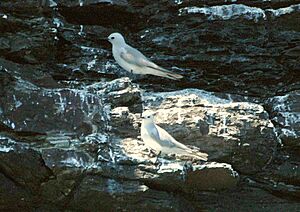Grey noddy facts for kids
Quick facts for kids Grey noddy |
|
|---|---|
 |
|
| Conservation status | |
| Scientific classification | |
| Genus: |
Anous
|
| Species: |
albivitta
|
The grey noddy or grey ternlet (Anous albivitta) is a type of seabird. It belongs to the family called Laridae, which includes gulls and terns. This bird was once thought to be just a lighter version of the blue noddy. But now, most scientists agree it is its own separate species.
Contents
How Scientists Name the Grey Noddy
The first official description of the grey noddy was made by a French bird expert, Charles Lucien Bonaparte. He described it in 1856. He gave it the scientific name Procelsterna albivitta. The name albivitta comes from Latin words. Albus means "white" and vitta means "band" or "head-band".
The grey noddy used to be in a group called Procelsterna. But in 2016, scientists studied the birds' DNA. They found that all five types of noddies are closely related. The grey noddy and blue noddy fit inside the group Anous. So, scientists decided to put all noddies into one main group, Anous. This means Procelsterna is now an older, less used name.
There are three main types, or subspecies, of the grey noddy:
- A. a. albivitta: Found on Lord Howe Island, Norfolk Island, the Kermadec Islands, and Tonga.
- A. a. skottsbergii: Lives on Henderson Island, Easter Island, and Isla Salas y Gómez (west of Chile).
- A. a. imitatrix: Breeds on the Desventuradas Islands (west of Chile).
What Does the Grey Noddy Look Like?
The grey noddy is about 28 to 31 centimeters (11 to 12 inches) long. Its wings can spread out 46 to 60 centimeters (18 to 24 inches) wide. It weighs around 75 grams (2.6 ounces). Its tail is quite long and has a small notch.
Its feathers are pale grey. They are almost white on its head and belly. But they are darker on its back, tail, and wings. The tips of its wings are dark. The back edge of its wings is white. The underside of its wings is mostly white.
The bird has black eyes that look big. This is because of a black patch in front of each eye. There is also a white patch behind each eye. Its thin, pointed bill is black. Its legs and feet are also black, but the webs between its toes are pale yellow.
Young grey noddies are browner than adult birds. Their flight feathers are darker and stand out more. The grey noddy is usually quiet. But it can make a soft, purring sound.
Where Do Grey Noddies Live?
This bird lives in warm ocean waters. You can find it in the subtropical and warm temperate parts of the south Pacific Ocean.
The A. a. albivitta subspecies nests on Lord Howe Island and Norfolk Island. It also breeds in northern New Zealand, especially the Kermadec Islands. You can also find it in southern Tonga. The A. a. skottsbergii subspecies lives on Henderson Island, Easter Island, and Isla Salas y Gómez. The A. a. imitatrix subspecies breeds on the Desventuradas Islands off the coast of Chile. Some grey noddies have also been seen in Australia and the Pitcairn Islands.
Grey Noddy Life and Habits
Grey noddies feed in shallow water. They do not fly far from their nesting places. They often gather in huge groups to find food. These groups can have thousands of birds.
They find food by hovering over the water. Then they drop down to pick up food from the surface. Their main food is tiny sea creatures called Plankton. They also eat small fish.
Grey noddies build their nests in colonies on rocky islands. They choose a sheltered spot on a rock. Sometimes they nest under a large rock or a clump of plants. The female bird lays just one egg. The egg is whitish with dark marks. Both parents take turns sitting on the egg. This is called incubation. It takes about 32 days for the egg to hatch. The young birds are fed food that their parents bring up from their stomachs. They are ready to fly after about 35 days.
See also
 In Spanish: Gaviotín de San Ambrosio para niños
In Spanish: Gaviotín de San Ambrosio para niños



